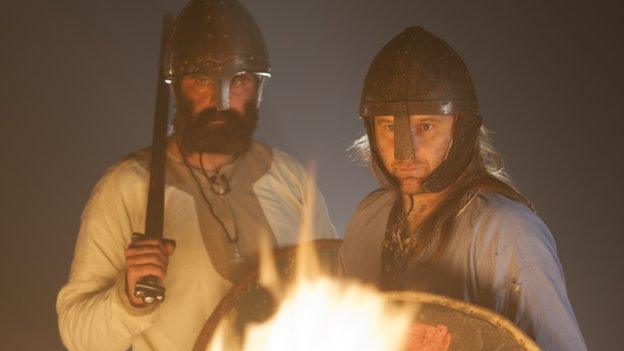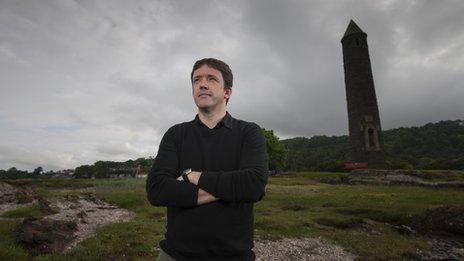The last battle of the Vikings
- Published

The Battle of Largs was the last time a Norwegian military force attacked Scotland
It was the battle which led to the end of Viking influence over Scotland, when a terrifying armada from Norway bore down on the Ayrshire town of Largs 750 years ago.
At the beginning of the 13th century the Firth of Clyde was frontier territory.
The mainland was Scottish but the islands of Bute and Cumbrae just across from Largs were Norse.
In fact, the whole of the Hebrides - a region known as Innse Gall - gave its allegiance to the Vikings from western Norway.
"It was a war just waiting to happen," says underwater archaeologist Dr Jon Henderson.
When the Vikings had first begun raiding across the North Sea 400 years earlier, there had been no king of Norway and no king of Scotland.
Their often savage raids evolved over time into trade and settlement.
Most of the west coast islands were dominated by Norse culture and were important for maintaining Viking power and influence.
In the early 1200s both countries were united under powerful and ambitious kings.

Dr John Henderson at the monument to the Battle of Largs
Haakon IV of Norway and Alexander II of Scotland were born within a few years of each other and came to the throne around the same time.
They were both determined to expand their authority.
Both men regarded Innse Gall as lying within their sphere of influence.
The struggle to control the Clyde islands spiralled into a battle over the whole of Innse Gall.
Over the next decades forces loyal to Alexander and Haakon fought a vicious running battle in the islands.
But Alexander's obsession with winning the Hebrides proved fatal when he sailed up the west coast with a powerful fleet in 1249.
He died of a fever as he tried to persuade island lords to sever links with Norway.
Show of force
By 1262, the kingdom of Norway was at the height of its power as it acquired Greenland and Iceland.
But Alexander III of Scotland was determined to back up his father's claims to the west coast islands.
He ordered raids deep into Norse territory. It was a brutal show of force.
"This was not just a land grab. This was ethnic cleansing," says Dr Henderson.
"This was an outrage which Haakon could not ignore."
The 59-year-old Norwegian king - an old man by the standards of the day - took personal command of the fleet.
"For Haakon, this was unfinished business. The chance to crush Scottish ambitions in the Hebrides once and for all," says Dr Henderson.
In Orkney, a Viking stronghold, his already powerful fleet was joined by local forces.
Haakon led his fleet through the Hebrides, island by island, demanding allegiance.
By the time he reached the disputed territories of the Clyde, he had 120 ships and up to 20,000 men at his command.
"It was a force that would have rivalled the Spanish Armada of 300 years later," says Dr Henderson.
Alexander, based down the coast in Ayr, knew he could not defeat Haakon at sea but if he could stall long enough then the autumn weather might do what his forces could not.
Haakon sent envoys to demand Alexander withdraw his claims but the Scottish king spun out the negotiations.
On 1 October 1263 the weather broke.
"The storm was so sudden and so powerful that survivors could only imagine it had been conjured up by sorcery," says Dr Henderson.
Haakon's fleet was scattered, with several ships driven ashore under the noses of local militia.
The next morning Haakon managed to get onshore with 1,000 men to salvage the ships and their cargo. That was when the Scots pounced.
Haakon's bodyguard got the king back to the safety of the fleet but on the shore the Norsemen were collapsing in disarray.
Dr Henderson says: "Finally a long ship managed to get ashore to reinforce the beleaguered rearguard and the Norsemen made a stand.
"The Battle of Largs petered out into a long distance and sporadic shooting match. Neither side had won. There was no decisive victory, just the usual grim reckoning in warfare.
"But if the skirmish fought on the Clyde coast did not decide anything, the aftermath would."
Bloody revenge
The Norse king's options were limited. Winter was approaching, his supplies were low and his men were getting restless.
He agreed to disperse the fleet and spend the winter in Orkney. He would return in the spring to have his bloody revenge on Alexander.
But Haakon did not see the spring. He died in Orkney on 16 December 1263.
He was the last Norwegian king to mount a military assault on Scotland.
His son Magnus the Lawmender was not interested in continuing the fight and just three years later he gave up the Hebrides and the Isle of Man to Scotland, in return for 4,000 marks in silver and an annual payment, under the Treaty of Perth.
At the same time the Scots recognised Norwegian rule over Shetland and the Orkney Islands.
"The Norse age was coming to an end," says Dr Henderson.
"For the descendants of the Vikings in the Hebrides things were beginning to change too.
"Although the Battle of Largs had not affected their culture or identity, it was to Scotland, not Norway, that they now looked for royal protection.
"The long slow process of becoming Scots had begun."